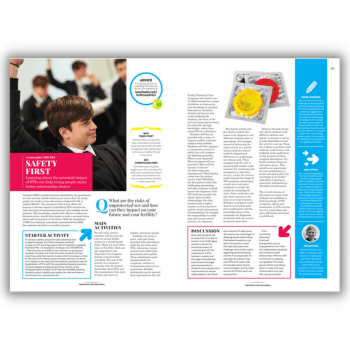Safeguarding in schools – Key principles every educator should know

It’s important to stay updated on recent developments in safeguarding, but we also need to actively listen to our students…

- by Teachwire

When it comes to safeguarding in schools, it’s crucial to be aware of the latest developments, but we must also remember the importance of listening to those under our care…
The issues that are leaving vulnerable students unprotected

We try to cover all safeguarding scenarios, but risk missing the most important duty of all, observes Dave Clements – that of listening…
It’s a familiar mantra – ‘Safeguarding is everybody’s business’ – but too often, it’s anything but. It’s an activity carried out by officialdom.
Safeguarding is a procedure you have to follow. It’s a box you must tick. It’s mandatory training. Something you endure then promptly forget about.
Procedures and checks are a necessity, albeit often overdone. But they can also become a prop, or an excuse for inaction.
They can short circuit real safeguarding – by which I mean the relationships between people that develop in communities. The kind of relationships that you can’t easily identify on school spreadsheets, or rigidly define in the pages of statutory guidance.
Well read
Working Together to Safeguard Children is the ‘safeguarding bible’. It details multi-agency arrangements to safeguard and protect children. It features flowcharts on who should do what and when, and runs to 168 pages.
Anybody working in a school is also expected to read the statutory guidance, Keeping Children Safe in Education. As I’m sure you know, this covers everything from the legislation intended to protect children and what staff need to know to keep them safe, down to safe recruitment practices and how to respond to concerns regarding staff.
And then there’s The London Safeguarding Children Procedures – which until recently was a hefty volume always found in the offices of children’s services (if not always observed), and these days has a sprawling online presence. Arranged alphabetically, that from which young Londoners must be protected would seem to include everything from animal abuse, begging and circumcision, to self harm, surrogacy and trafficking.
Fostering mistrust
For all the documentation and bureaucratisation of our children’s safeguarding infrastructure, one fundamental question remains: ‘Are our children any safer as a result?’
When I worked in children’s social care, I was under no illusions regarding some of the awful cases we dealt with. These would typically concern a small number of ‘chaotic’ families beset by drugs, alcohol, abuse, neglect and/or violence – but I was also keen to keep things in perspective.
It seemed to me that the damage done by exaggerating the extent of abuse and fostering mistrust in each other was out of all proportion to the peril brought about by its actual incidence. Despite what some in the industry would irresponsibly claim, abuse wasn’t (and isn’t) ‘widespread’. Indeed, the cases of abuse we hear about the most are typically the rarest of all.
Parental concerns
Those of us who have worked in and around safeguarding, or are grappling with these sorts of issues in schools, could do worse than actually speak to parents. What worries them? Is it the risk of female genital mutilation?
According to the Metropolitan Police, following a recently successful conviction for the practice, it was ‘Only the second time in UK history that somebody has been convicted of FGM since it became illegal in 1985’. And the offence in question wasn’t even committed in the UK.
Or are parents worried about knife crime? Their kids being glued to their devices? Are Jewish parents afraid to send their children to school wearing kippahs because of rising antisemitism? Why aren’t we worrying more about ‘extremism’? There have been recent break-ins, racial slurs and threats of arson made against Barclay and Michaela schools in East and West London respectively.
At the time of writing, Michaela has recently seen its ‘prayer ban’ – which sparked spurious allegations of Islamophobia – ruled lawful. But wherever you stand in that particular debate, it seems as though there’s been a notable absence of outrage against the attacks on these schools.
The incidents at Barclay happened in the midst of ‘pro-Palestine’ protests featuring angry scenes. As a parent, I know of primary-aged children who have got into disputes with peers over the wearing of Palestinian scarves, and the same keffiyeh worn by Hamas and its supporters being displayed on the badges of well-to-do parents at the school gates. If it’s in the playground and at the school gates, is it in the staff room too?
A hierarchy of risk
Why do we seem to care about some safeguarding risks more than others? Why do we worry about vanishingly small risks, yet appear far less interested in safeguarding against other bigger and avoidable risks?
The recently published Cass Review (see cass.independent-review.uk) documents how a number of gay and autistic children have been subjected to irreversible gender transitioning – and yet we’re still teaching kids that they can change their gender.
On the other hand, we’re also safeguarding too much. Whether it’s a school trip, or a child in care refused a sleepover, otherwise valuable experiences are too often getting tangled up in a backside-covering culture of compliance and consent forms.
Growing up in communities
Of course, there are some genuine safeguarding concerns – from schools removing items from young people who then accuse the school of assaulting them, to the reservations expressed by some parents regarding inappropriate lesson content being taught in schools.
Indeed, the greatest damage done to our children in living memory occurred during the pandemic. While the virus itself posed little threat to the young, the impact of closing down schools was profound. As numerous reports have since shown – and as teachers have seen for themselves close up – the social, emotional and academic consequences have been all too real.
By contrast, we can’t seem to cease worrying over kids and their devices. In February, the government issued guidance backing school bans on smartphones, and is now reportedly considering banning their sale to under 16s.
You can understand their reasoning. Today, most of us are glued to our phones and living lives often embedded as much in social media as what we used to call the ‘real world’.
It follows that this can’t be good for kids. Jonathan Haidt, a psychology professor at New York University’s Stern School of Business, was right when he was quoted in The Spectator as saying, “You cannot grow up in networks. You have to grow up in communities.”
Making lives easier
But our communities have changed beyond recognition. Both parents now often have to work, and many can’t afford the considerable expense of childcare. Is it any wonder, given these circumstances, that kids are increasingly babysat by devices and accessing stuff they probably shouldn’t be?
A government genuinely set on ‘Making the UK the safest place to be a child online’ might have tried to make parents’ lives a little easier, over introducing the draconian Online Safety Act.
We have responsibilities too. We’re encouraged by authorities to disengage, to not take matters into our own hands – but this unwillingness to intervene can result in bad behaviour going unchecked, and leave vulnerable kids unprotected.
If we want our schools and communities to be safe and secure places in which our young people can thrive, then we’re going to have to look up from our policies, procedures, laptops and phones – and start actually talking to each other.
Dave Clements is a local government policy advisor and associate of the Education Forum at the Academy of Ideas.
What areas should leaders prioritise in 2023/24?
Ann Marie Christian highlights the safeguarding developments and priorities that school leaders should heed this academic year…
Some years ago, safeguarding arrangements within schools became an important part of Ofsted’s inspection framework.
Part of my role involves visiting schools across the world and inland UK to carry out reviews and audits of schools’ safeguarding provision. This is a privileged position that enables me to notice a range of recurrent safeguarding themes and concerns. I’m going to share these with you here.
In 2015, Dr Carlene Firmin from University of Bedfordshire introduced the concept of ‘Contextual safeguarding’. The government eventually added ‘Risk outside the family home’ to its statutory Keeping Children safe in Education (KCSiE) guidance.
This meant that schools and colleges would now be expected to monitor risks in their local area and join families in supporting pupils’ safety accordingly.
The upshot was that schools began to regularly liaise not just with parents on safeguarding matters, but also police authorities, local retailers, businesses and other local organisations.
Despite progress being made in the years since then, I’ve still seen first-hand how pupils will speak of worries regarding their journeys to school. They identify certain underpasses, alleyways and bus routes as being potentially dangerous.
School staff often won’t be aware of these concerns, especially those driving in each day from other villages and towns. Yet it remains the case that inspectors will routinely ask contextual safeguarding questions during inspections. This means school and college staff should be aware of nearby trouble spots and any action by local partnership agencies.
That’s why it’s vital to prepare recent case studies that demonstrate how your school has successfully protected children using the contextual safeguarding model.
Bullying and microaggressions
Next, child-on-child harm. Back in the pre-‘Everyone’s Invited’ world, the DfE published its first Sexual Violence and Harassment Guidance for Schools and Colleges in 2017. The DfE subsequently revised this in 2018 and 2021.
More recently, the guidance has been embedded in Part Five of the KCSiE 2022 guidance. It was expanded to include physical harm, sexual harm, neglect, emotional harm and harms stemming from child-on-child incidents. The latter, more commonly known as ‘bullying’, has been with us for many years, of course – but how often and how consistently are you currently recording such incidents?
Many pupils in school settings will frequently experience microaggressions. Pupils with protected characteristics will often experience them almost daily from peers, and even sometimes – if unintentionally – from school staff.
Pupils will frequently detail microaggressions they’ve experienced to trusted peers and chosen staff. When it’s fed back to staff, the nature of the microaggressions – especially racism – will be known to them already. But they may not necessarily know their short- and long-term impact or frequency.
Issues relating to gender, sexuality and LGBTQIA+ identity will commonly come up in this context and in discussions with senior leaders.
If you don’t already, reflect on the gendered pronouns we all use daily. Think about the impact this can have on pupils who may be non-binary or otherwise questioning their gender.
We can reduce harms by working to make the language we use more inclusive and welcoming to all. Have you, for instance, questioned the titles of ‘head girl’ and ‘head boy?’ Could you simply recognise your ‘head pupils’ instead?
I should also note that neurodiverse pupils are more likely to experience microaggressions than most. This is sometimes due to not understanding the intent of sarcasm directed at them. As a result they experience child-on-child harms.
Conduct, contact, content, commerce
It’s perhaps to be expected, yet still disappointing to see that sexism, racism, and homophobia all continue to be major safeguarding concerns.
With influencers like Andrew Tate and others effectively promoting hate crime on social media, the DfE has responded by updating its KSCiE guidance to include ‘four C’s’ that schools should teach through the curriculum.
These comprise ‘Conduct’, ‘Contact’, ‘Content’ and ‘Commerce’. These are intended to cover topics such as fake news; the sending and receiving of abusive or threatening messages; the production of inappropriate content and problem gambling, among others.
Another trend increasingly seen across schools is the adoption of discriminatory, and thus de facto unlawful uniform policies. I recently visited a Christian school where Muslim children could apply and the school would accept them on roll. However, they were not allowed to wear their hijab at school. Staff could wear them – but not students.
We also continue to see huge misunderstandings when the basic physical properties of textured, curly and afro hair conflict with schools’ expectations around students’ personal appearance and hair styling. I’m aware of one boarding school that told a student his Afro was too high. Are there any schools telling children with ‘European hair’ to cut it because it’s too long?
Finally, a relatively recent consideration for schools are the arrangements around changing rooms, boarding houses, toilets and dormitories on residential trips, and whether we need to adapt these to support transgender and non-binary pupils. It’s important to bear in mind that the legal safeguarding framework requires schools to protect the welfare of every child.
Too much responsibility?
This brings us to matters of safeguarding governance, and the failures caused when schools appoint individuals lacking adequate expertise and preparation to the ‘link governor’ role responsible for safeguarding.
Some chairs have consequently opted to take on the link governor role themselves, in addition to their existing duties. Both roles are essential, but together, they entail a huge amount of responsibility for one person.
Given the importance of safeguarding in school inspections, we can perhaps excuse this move if schools enact it as a strictly temporary arrangement, but not if they intend it as a long-term solution.
Best practice in this area would see the formation of dedicated safeguarding subcommittees. These would be responsible for scrutinising all safeguarding expectations. This is everything from being vigilant around issues such as female genital mutilation, to managing their school’s Prevent duties and implementing safe recruitment policies.
Joint working between a school’s HR team and the Designated Safeguarding Lead is essential for getting recruitment right. In 2014, the government removed specific training expectations and renewal dates concerning safer recruitment practices from the KCSiE guidance. This led to a noticeable deterioration in knowledge and updates in this area thereafter. Things get more complicated still when the HR team of a local authority is working to different standards than the centralised HT teams of nearby MATs.
More recently, it’s the case that many schools and colleges are still yet to fully complete their required online safer recruitment training. Yet they’ll boast about their latest training attendance figures.
Needless to say, when it comes to light that they’re unaware of statutory safeguarding changes made since 2020, things start to get awkward…
A question of trust
Last of all, let’s talk about agency-sourced catering, cleaning and supply staff. Schools typically trust their agencies to follow robust recruitment practices, but will rarely be aware of the relevant details.
Have people at the relevant agencies attended safer recruitment training within the last three years? Can they produce any certification? Does the agency bring up any safeguarding questions during face-to-face interviews? Have they had sight of their workers’ DBS certificates?
School staff will often assume that agency workers have received safeguarding training within the last 12 months. But how do they know for sure? How many agency staff have actually read the latest KCSiE guidance and signed to confirm they understand it?
Is your safeguarding provision up to date?
- Read the latest KCSiE guidance from front to back. Highlight any changes you see compared to previous revisions and when/how you will enact these
- Ensure key staff have attended credible safer recruitment training. Firmly embed the 2020 changes within your recruitment processes
- Visit the Contextual Safeguarding website to complete a mapping exercise concerning nearby locations where students feel unsafe
- Carry out a pupil survey asking them about child-on-child harms (whether emotional, physical, neglectful and/or sexual in nature). This will help you better understand their lived experience
Ann Marie Christian is a safeguarding and child protection expert; for more information, visit annmariechristian.com. Browse resources for Child Safety Week.







